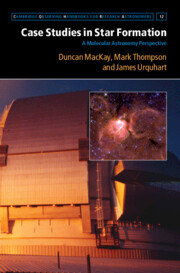Book contents
- Frontmatter
- Dedication
- Contents
- Preface
- List of Acronyms
- Part I Introduction
- Part II Low-Mass Star Formation (LMSF)
- 2 Two LMSFR Surveys Using IRAM and ALMA
- 3 IRAS 16293 in Ophiuchus
- 4 NGC 1333 in Perseus
- 5 IRAS 15398 in Lupus
- Part III High-Mass Star Formation (HMSF)
- Part IV Ionisation
- Part V Photodissociation
- Part VI External Galaxies
- Appendices
- List of Research Journal Abbreviations
- References
- Chemical Index
- Subject Index
2 - Two LMSFR Surveys Using IRAM and ALMA
from Part II - Low-Mass Star Formation (LMSF)
Published online by Cambridge University Press: 11 April 2023
- Frontmatter
- Dedication
- Contents
- Preface
- List of Acronyms
- Part I Introduction
- Part II Low-Mass Star Formation (LMSF)
- 2 Two LMSFR Surveys Using IRAM and ALMA
- 3 IRAS 16293 in Ophiuchus
- 4 NGC 1333 in Perseus
- 5 IRAS 15398 in Lupus
- Part III High-Mass Star Formation (HMSF)
- Part IV Ionisation
- Part V Photodissociation
- Part VI External Galaxies
- Appendices
- List of Research Journal Abbreviations
- References
- Chemical Index
- Subject Index
Summary
The chapter presents two surveys of low-mass star formation regions (LMSFR). The first survey uses the IRAM (Institute for Radio Astronomy in the Millimeter Range) 30 metre telescope at Pico Veleta in Spain to identify 16 deeply embedded YSOs and the emission from eight complex organic molecules (COMs). The second survey uses ALMA (Atacama Large Millimetre Array) directed towards five low-mass candidates (all in the Serpens cluster at distances ~440 pc) and detected emission from five COMs species.
- Type
- Chapter
- Information
- Case Studies in Star FormationA Molecular Astronomy Perspective, pp. 27 - 45Publisher: Cambridge University PressPrint publication year: 2023

